

Fossils
Location: Tate Hall Museum, second floor
Please note that the Tate Hall Museum is currently closed.
Step back in time and get hands on with some real fossils. Learn more about ‘Liverpool’s own dinosaur’ and marvel at a type specimen trace fossil 240,000,000 years old!
Fossils are the remains or traces of ancient life that have been preserved by natural processes, from spectacular skeletons to tiny sea shells.
Imprints, tracks and trails can also become fossilised, like dinosaur footprints. These are called trace fossils.
Imprints, tracks and trails can also become fossilised, like dinosaur footprints. These are called trace fossils.
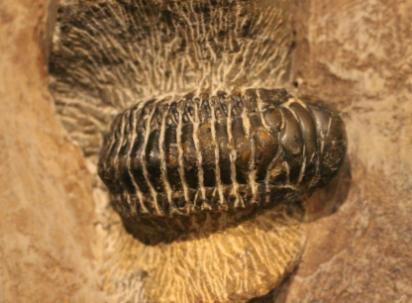
This is an example of a trilobite in the museum
The oceans were once filled with trilobites, ancient animals that are some of the first creatures with hard parts found in the fossil record. Trilobites are arthropods, a group of animals that includes spiders, scorpions, crustaceans and insects. These animals lived on the floor of an ancient ocean and their remains were brought together after death, probably by the action of sea currents. It is likely that these trilobites were predators or scavengers, feeding on small invertebrates or their remains, or detritivores that fed on decaying matter on the seafloor.
250 million years ago, trilobites became extinct thought to have been brought about by a rapid climate change.
The oceans were once filled with trilobites, ancient animals that are some of the first creatures with hard parts found in the fossil record. Trilobites are arthropods, a group of animals that includes spiders, scorpions, crustaceans and insects. These animals lived on the floor of an ancient ocean and their remains were brought together after death, probably by the action of sea currents. It is likely that these trilobites were predators or scavengers, feeding on small invertebrates or their remains, or detritivores that fed on decaying matter on the seafloor.
250 million years ago, trilobites became extinct thought to have been brought about by a rapid climate change.
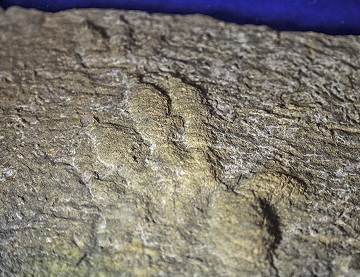
This is a trace fossil made by ‘Liverpool’s own dinosaur’ the CHIROTHERIUM.
Trace fossils are the imprint of tracks and burrows made by animals as they went about their lives millions of years ago.
Dinosaur footprints are probably the most dramatic trace fossils but many others tell fascinating stories.
The footprints here are commonly said to have been made by ‘Liverpool’s own dinosaur’. The footprints were first found in Germany and then closer to home in quarries in Storeton on the Wirral and Lymm in Cheshire. They were found when the Triassic sandstone was being excavated to be used extensively in building works across Merseyside and Cheshire during the 1850’s.
The animal that made these footprints was not a dinosaur. It was a large reptile that belonged to a group of reptiles that were ancestors of both dinosaurs and crocodiles.
The footprints are called ‘Chirotherium’, because of their resemblance to human hands. The term Chirotherium comes from two Greek words meaning ‘hand animal’. A characteristic feature of these footprints is the ‘thumb’ on the outside of the print. Look at your own hand and you will see the opposite. Your thumb points towards the centre of your body. The outside thumb was common in a group of reptiles that existed before dinosaurs and was probably only functioning to provide a firmer grip in mud.
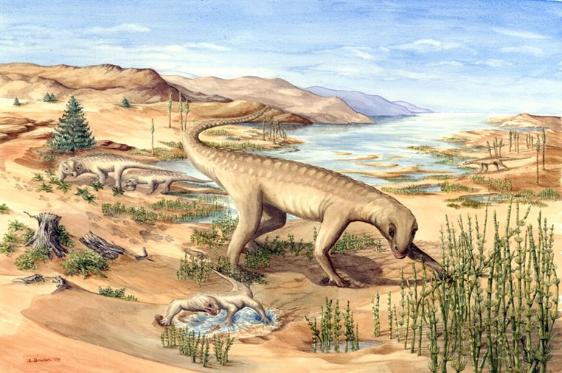
This is a recent watercolour interpretation of a Chirotherium in its Merseyside habitat based on fossil evidence.
Image © F. L. J Bowden
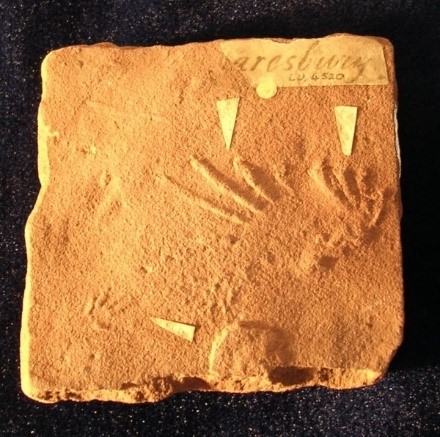
Beasley’s D2 type-specimen, c. 240,000,000 years old.
Rhynchosaurides Rectipes’
This is a 240,000,000 years old Type specimen which can be seen in the natural history displays in the Tate Hall museum.
What is a Type Specimen?
Scientists such as zoologists, oceanographers, geologists and palaeontologists, name all the nature that can be seen in the world and in our museums. Sometimes they will come across a specimen that has never been seen before and is completely new to science.
These are known as ‘type specimens’ which is the definition given to the first example of its type ever discovered. Over 200,000,000 years ago, a small herbivorous reptile walked across a North West landscape very different from the one we know today.
The local sandstone quarries produced many important discoveries of trace-fossil footprints made by extinct Triassic vertebrates. This footprint, made by ‘Beasley’s type D2 Rhynchosaurides Rectipes’ represents the history of the landscape, as well as the Liverpool Geological Society, established in 1859, which made study of such finds.
A Rhynchosaurus which had a stocky body and a powerful beak. They would have broad skulls, reptilian skin and grew to the size of a pig. Their jaws had a scissor-like action, which enabled them to cut up tough plant material. The Rhynchosaurus was probably preyed upon by the Triassic reptile Chirotherium above.
Rhynchosaurides Rectipes’
This is a 240,000,000 years old Type specimen which can be seen in the natural history displays in the Tate Hall museum.
What is a Type Specimen?
Scientists such as zoologists, oceanographers, geologists and palaeontologists, name all the nature that can be seen in the world and in our museums. Sometimes they will come across a specimen that has never been seen before and is completely new to science.
These are known as ‘type specimens’ which is the definition given to the first example of its type ever discovered. Over 200,000,000 years ago, a small herbivorous reptile walked across a North West landscape very different from the one we know today.
The local sandstone quarries produced many important discoveries of trace-fossil footprints made by extinct Triassic vertebrates. This footprint, made by ‘Beasley’s type D2 Rhynchosaurides Rectipes’ represents the history of the landscape, as well as the Liverpool Geological Society, established in 1859, which made study of such finds.
A Rhynchosaurus which had a stocky body and a powerful beak. They would have broad skulls, reptilian skin and grew to the size of a pig. Their jaws had a scissor-like action, which enabled them to cut up tough plant material. The Rhynchosaurus was probably preyed upon by the Triassic reptile Chirotherium above.
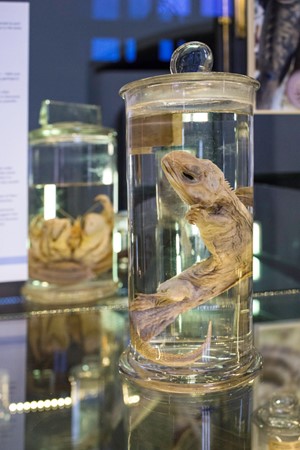
You can see the closest ancestor to the Rhynchosaurus in the museum. It is part of our wet collection and is the Sphenodon or Tuatara: these are reptiles native to New Zealand.